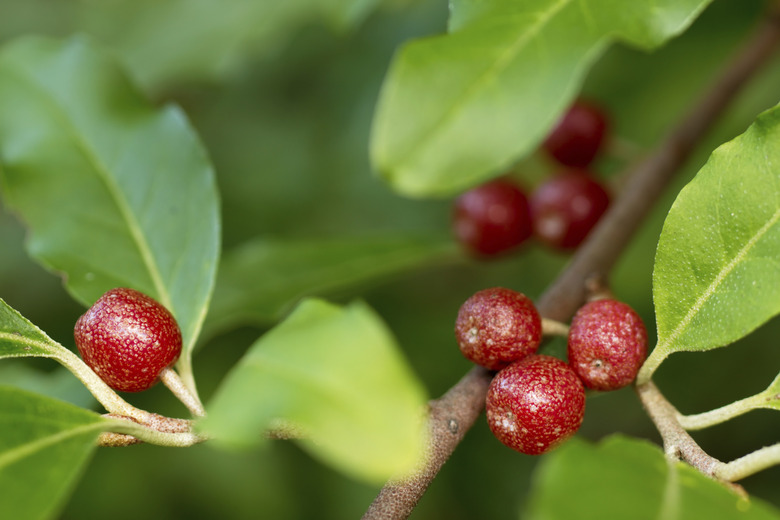Facts On The Russian Olive Tree
Although grown as a small ornamental tree, the Russian olive (Elaeagnus angustifolia) is considered invasive in certain parts of the United States. Not a true olive, it is a native of Asia, and its large, speckled, yellow or reddish-brown berries appeal only marginally to birds and small mammals. The Russian olive's habit of wiping out large areas of native growth, however, places it low on the list of trees that provide a valuable food supply and a habitat for wildlife.
Identification Characteristics
Growing to roughly 30 feet and occasionally taller, the Russian olive is often as wide as it is tall and tends to lean as it matures. Its smooth, silvery leaves resemble those of a willow tree and measure 1 to 4 inches long by 1/2 to 1 inch wide. Young stems are silver and scaly, turning brown and smooth, and sometimes developing thorns as they age. Each Russian olive flower is composed of four white or yellow petals that open in late spring. The berries, or olives, appear in late summer and early fall, and they measure about 1/2 inch long. They have a silver scale and remain on the tree all winter.
Range and Habitat
Russian olive grows across much of the United States in areas that were disturbed by excavation, fire or weather events and along streams and rivers. It also grows in fields, along woodland edges and in very dry or wet areas where other species struggle to survive. It is hardy in U.S. Department of Agriculture plant hardiness zones 3 through 8, where it tolerates extremes of weather that range from severe cold to high heat and humidity. The Russian olive thrives in a wide range of soil types and has a very high tolerance for salty soil and drought, as well as extremes in acidity and alkalinity.
Reproduction and Growth
The tree reproduces by small seeds contained in its berries and also from sprouts and suckers that grow from its base. Because the fruits stay on the tree in winter, the seeds are dispersed mainly in droppings from birds that ate the fruits. Like legumes, the Russian olive produces its own nitrogen in soil through small nodules attached to its roots. Although the tree grows best in full, direct sunlight, it tolerates some shade.
Invasiveness Status
The Russian olive's capacity to overtake other plants is well-documented; it competes with them for nutrients, moisture and light. As of mid-2014, the tree was classified as a "noxious weed" in Colorado, New Mexico and Connecticut, where its growth is banned, according to the USDA Natural Resources Conservation Service. In addition, the service lists California, Nebraska, Wisconsin and Wyoming as states where Russian olive is considered invasive or weedy. Even though Russian olive is not banned in those states, growing it there is highly discouraged.
References
- U.S. Forest Service, Forest Invasive Plants Resource Center: Autumn Olive and Russian Olive
- Minnesota Department of Natural Resources: Russian Olive (Elaeagnus Angustifolia)
- U.S. Department of Agriculture, Forest Service: Elaeagnus Angustifolia (Russian Olive)
- U.S. Department of Agriculture, Natural Resources Conservation Service: Elaeagnus Angustifolia L. (Russian Olive)
- Missouri Department of Conservation Online: Russian Olive
